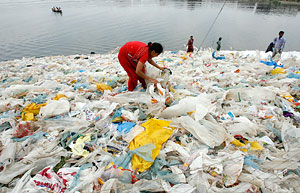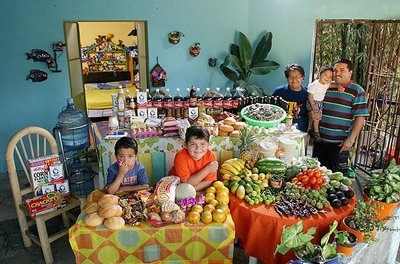 Once upon a time, the “Paper or plastic?” question seemed like it could go either way. Choose plastic and you’re choosing something that may be stuck in landfills for hundreds of years. Choose paper and you’re sacrificing trees (“it takes 14 million trees to produce the 10 billion paper grocery bags used every year by Americans”). But it’s way more complicated than that. From an excellent article at Salon:
Once upon a time, the “Paper or plastic?” question seemed like it could go either way. Choose plastic and you’re choosing something that may be stuck in landfills for hundreds of years. Choose paper and you’re sacrificing trees (“it takes 14 million trees to produce the 10 billion paper grocery bags used every year by Americans”). But it’s way more complicated than that. From an excellent article at Salon:
Every year, Americans throw away some 100 billion plastic bags after they’ve been used to transport a prescription home from the drugstore or a quart of milk from the grocery store. It’s equivalent to dumping nearly 12 million barrels of oil. … Only 1 percent of plastic bags are recycled worldwide.
The bags look like jellyfish to a lot of marine life. The bags that don’t get “eaten” become part of the flotsam that now clogs every square inch of the world’s now fully plastinated oceans (some sections of ocean now carry 6x more plastic than biomass).
more than a million birds and 100,000 marine mammals and sea turtles die every year from eating or getting entangled in plastic. The conservation group estimates that 50 percent of all marine litter is some form of plastic. There are 46,000 pieces of plastic litter floating in every square mile of ocean, according to the United Nations Environment Programme.
Despite the hopeful-looking recycling symbol on the side of most plastic bags, recycling centers can’t handle them – they bring most recycling equipment to a screeching halt. You’re better off bringing them back to the store where you got them.
“The only salient answer to paper or plastic is neither. Bring a reusable canvas bag, says Darby Hoover, a senior resource specialist for the Natural Resources Defense Council.”
Sadly, environmental incentives to get people to bring their own canvas bags shopping have never worked. But economic incentives might. IKEA now charges customers five cents per plastic bag, and donates the proceeds to an environmental working group. Fashion might work too:
Bringing your own bag — or BYOB as Whole Foods dubs it — is the latest eco-chic statement. When designer Anya Hindmarch’s “I am not a plastic bag” bag hit stores in Taiwan, there was so much demand for the limited-edition bag that the riot police had to be called in to control a stampede, which sent 30 people to the hospital.
Earthresource.org is running the Campaign Against The Plastic Plague.




 Que es
Que es